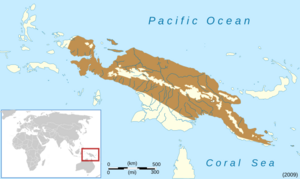Callulops robustus facts for kids
Quick facts for kids Callulops robustus |
|
|---|---|
| Conservation status | |
| Scientific classification | |
 |
|
| Synonyms | |
|
Mantophryne robusta Boulenger, 1898 |
The Callulops robustus frog is often called the Boulenger's callulops frog or robust frog. It's a type of frog that belongs to the Microhylidae family. For a long time, scientists thought this frog lived in many places, including Western New Guinea (in Indonesia) and Papua New Guinea.
However, scientists now believe that frogs found in different places might actually be different species. This means the name Callulops robustus might only belong to the frogs found on Misima Island. The frogs living on the mainland of New Guinea might be a different species that doesn't have a scientific name yet. Also, another frog called Callulops microtis was once thought to be the same as Callulops robustus, but it's now known to be a separate species.
What Does It Look Like?
Callulops robustus are medium-sized frogs. Male frogs usually grow to be about 61 to 65 millimeters long. Female frogs are a bit larger, growing from 60 to 78 millimeters long. These frogs have a long nose, which scientists call a snout.
Adult frogs are usually reddish-brown or grey-brown on their backs. Their chin, chest, and the underside of their legs are dark purple-brown. Young frogs, called juveniles, look quite different! They have a black head and black legs. Their back and sides are brick-red, and they have tiny blue-white spots scattered all over.
Where Do They Live and Are They Safe?
The robust frog is found in many areas, but there aren't huge numbers of them in any one spot. They live in lowland and hill rainforests. You can also find them in places where the forest has been changed by people or nature. This includes areas like degraded forests, forest edges, rural gardens, and near landslides. They can live at elevations up to 1,920 meters above sea level.
These frogs like to dig and hide in the forest floor. They have a special way of having babies called direct development. This means their eggs hatch directly into tiny frogs, without going through a tadpole stage first! The good news is that there are no major threats to this frog species right now.


